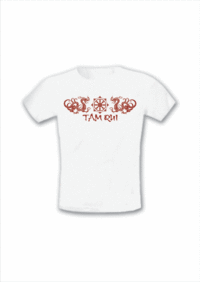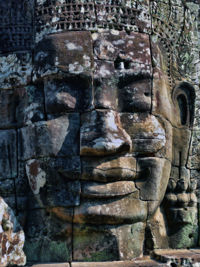Amitabha Buddha
From Buddha World
Amitābha (Sanskrit: अमिताभ, Amitābha (wordstem); Chinese: Ēmítuó Fó; Tibetan: Ö-pa-me) is a celestial buddha described in the scriptures of the Mahāyāna school of Buddhism. Amitabha is the principal buddha in the Pure Land sect, a branch of Buddhism practiced mainly in East Asia. According to these scriptures, Amitābha possesses infinite merits resulting from good deeds over countless past lives as a bodhisattva named Dharmakāra. "Amitabha" is translatable as "Infinite Light," hence Amitabha is often called "The Buddha of Infinite Light."
Doctrine
According to the Larger Sūtra of Immeasurable Life Amitābha was, in very ancient times and possibly in another realm, a monk named Dharmakāra. In some versions of the sūtra, Dharmakāra is described as a former king who, having come into contact with the Buddhist teachings through the buddha Lokesvararaja, renounced his throne. He then resolved to become a buddha and so to come into possession of a buddhakṣetra ("buddha-field", a realm existing in the primordial universe outside of space time, produced by a buddha's merit) possessed of many perfections. These resolutions were expressed in his forty-eight vows, which set out the type of buddha-field Dharmakāra aspired to create, the conditions under which beings might be born into that world, and what kind of beings they would be when reborn there.
In the versions of the sutra widely known in China, Vietnam, Korea and Japan, Dharmakāra's eighteenth vow was that any being in any universe desiring to be born into Amitābha's Pure Land and calling upon his name even as few as ten times will be guaranteed rebirth there. His nineteenth vow promises that he, together with his bodhisattvas and other blessed Buddhists, will appear before those who call upon him at the moment of death. This openness and acceptance of all kinds of people has made the Pure Land belief one of the major influences in Mahāyāna Buddhism. Pure Land Buddhism seems to have first become popular in northwest India/Pakistan and Afghanistan, from where it spread to Central Asia and China, and from China to Vietnam, Korea and Japan. The sutra goes on to explain that Amitābha, after accumulating great merit over countless lives, finally achieved buddhahood and is still alive in his land of Sukhāvatī, whose many virtues and joys are described. The basic doctrines concerning Amitābha and his vows are found in three canonical Mahāyāna texts:
- The Larger Sukhāvatīvyūha Sūtra
- The Smaller Sukhāvatīvyūha Sūtra
- The Amitāyurdhyāna Sūtra (Sutra on the Meditation on Amitāyus).
Through his efforts, Amitabha created the "Pure Land" (Chinese: jìngtŭ; Japanese: jōdo; Vietnamese: tịnh độ) called Sukhāvatī (Sanskrit: "possessing happiness") . Sukhāvatī is situated in the uttermost west, beyond the bounds of our own world. By the power of his vows, Amitābha has made it possible for all who call upon him to be reborn into this land, there to undergo instruction by him in the dharma and ultimately become bodhisattvas and buddhas in their turn (the ultimate goal of Mahāyāna Buddhism). From there, these same bodhisattvas and buddhas return to our world to help yet more people.
Amitabha in Vajrayana Buddhism
Amitābha is also known in Tibet, Mongolia, and other regions where Tibetan Buddhism is practiced. In the Highest Yoga Tantra class of the Tibetan Vajrayana Amitabha is considered one of the Five Dhyāni Buddhas (together with Akṣobhya, Amoghasiddhi, Ratnasambhava, and Vairocana), who is associated with the western direction and the skandha of saṃjñā, the aggregate of distinguishing (recognition) and the deep awareness of individualities. His consort is Pandava, his realm is called either Sukhāvatī (Sanskrit) or Dewachen (tibetan). As his two main disciples, similar as the Buddha Shakyamuni had two, are seen the Bodhisattvas Vajrapani and Avalokiteshvara, the former to his left and the latter to his right. In Tibetan Buddhism, there exists a number of famous prayers for taking rebirth in Sukhavati (Dewachen). One of these was written by Je Tsongkhapa on the request of Manjushri, who appeared to him in different visions. The Tibetan Panchen Lamas and Shamarpas are considered to be incarnations of Amitabha. He is frequently invoked in Tibet either as Buddha Amithaba - especially in the Powa practices or as Amitāyus - especially in practices relating to longevity and preventing an untimely death. In Japanese Vajrayana, or Shingon Buddhism, Amitabha is seen as one of the thirteen Buddhist deities practitioners pay homage to. Shingon, like Tibetan Buddhism, also uses special devotional mantras for Amitabha, though the mantras used differ. Amitabha is also one of the Buddhas featured in the Womb Realm Mandala used in Shingon practices, and sits to the west, which is where the Pure Land of Amitabha is said to dwell.
Mantras
Amitabha is the center of a number of mantras in Buddhist Vajrayana practices. The Indic form of the mantra of Amitābha is oṃ amitābha hrīḥ, which is pronounced in its Tibetan version as Om ami dhewa hri. The Japanese Shingon Buddhist mantra is On amirita teizei kara un which represents the underlying Indic form oṃ amṛta-teje hara hūṃ. In addition to using the mantras listed above, many Buddhist schools invoke Amitabha's name in a practice known as 'nianfo' in Chinese and 'nembutsu' in Japanese.
Names in various languages
The proper form (wordstem) of Amitābha's name in Sanskrit is Amitābha, masculine, and the nominative singular is Amitābhaḥ. This is a compound of the Sanskrit words amita ("without bound, infinite") and ābhā ("light, splendor"). Consequently, the name is to be interpreted as "he who possesses light without bound, he whose splendor is infinite". The name Amitāyus (nominative form Amitāyuḥ) is also used. This is a compound of amita ("infinite") and āyus ("life"), and so means "he whose life is boundless". In Chinese, his name is given as Āmítuó Fó, where Āmítuó is the Chinese representation of the first three syllables of either Amitābha or Amitāyus, and Fó is Chinese for Buddha (a very early borrowing of the first syllable of the Sanskrit word). The name Amitābha is given in Chinese as Wúliàngguāng ("Infinite Light"), while the name Amitāyus is given as Wúliàngshòu ("Infinite Life"). These names are not, however, very commonly used. In Vietnamese, Korean, and Japanese, the same Chinese characters used for Amitabha are used to represent his name, though they are pronounced slightly differently:
- Vietnamese: A-di-đà Phật
- Korean: Amit'a Bul
- Japanese: Amida Butsu.
In Japanese, he is also called Amida Nyorai, meaning "Amitābha the Tathāgata". In Tibetan, Amitābha is called 'od.dpag.med and, as Amitāyus, tshe.dpag.med.
Iconography
It can be difficult to distinguish Amitābha from Śākyamuni, as both are portrayed as possessing all the attributes of a buddha but no distinguishing marks. Amitabha can, however, often be distinguished by his mudrā: Amitābha is often depicted, when shown seated, displaying the meditation mudrā (thumbs touching and fingers together (as in the Kamakura statue of Amitābha) or the exposition mudrā, while the earth-touching mudrā (right hand pointed downward over the right leg, palm inward) is reserved for a seated Śākyamuni alone. He can also be seen holding a lotus in his hands while displaying the meditation mudrā. When standing, Amitābha is often shown with his left arm bare and extended downward with thumb and forefinger touching, with his right hand facing outward also with thumb and forefinger touching. The meaning of this mudra is that wisdom (symbolized by the raised hand) is accessible to even the lowest beings, while the outstretched hand shows that Amitabha's compassion is directed at the lowest beings, who cannot save themselves. When not depicted alone, Amitābha is often portrayed with two assistants: Avalokiteśvara (Guānyīn) who appears on his right and Mahāsthāmaprāpta (Dà Shì Zhì) who appears on his left. In Tibetan Buddhism, Amitābha is red in color (red being the color of love, compassion, and emotional energy). His direction is west and so he is envisioned as the (red) setting sun. He is seen as the supreme power and energy of nature, cast on an earthly plain, accessible to all sentient beings. For this reason he is considered one of the most popular of all Dhyāni Buddhas. His unique emblem is the lotus. He is thus associated with the attributes of the lotus: gentleness, openness, and purity.
Archeological origins
Táng Dynasty Amitābha sculpture — Hidden Stream Temple Cave, Longmen Grottoes, China The first known epigraphic evidence for Amitābha is the bottom part of a statue found in Govindnagar, Pakistan and now located at the Mathura Museum. The statue is dated to "the 28th year of the reign of Huviṣka" (i.e., sometime in the latter half of the second century CE, during the period of the Kuṣāṇa Empire), and was apparently dedicated to "Amitābha Buddha" by a family of merchants. The first known sutra mentioning Amitābha is the translation into Chinese of the Pratyutpanna Sūtra by the Kuṣāṇa monk Lokakṣema around 180 CE. This work is said to be at the origin of Pure Land practice in China. The appearance of such literature and sculptural remains at the end of the 2nd century suggests that the doctrine of Amitābha probably developed during the 1st and 2nd centuries CE.
Будда Амитабха7.jpg
|
||











 Русский
Русский
